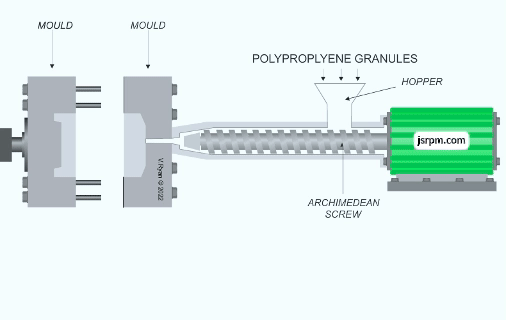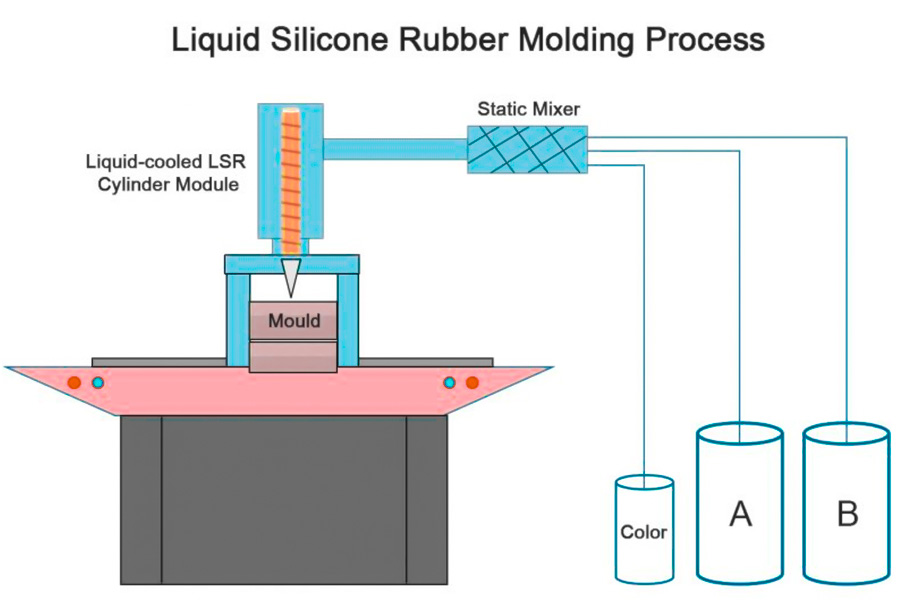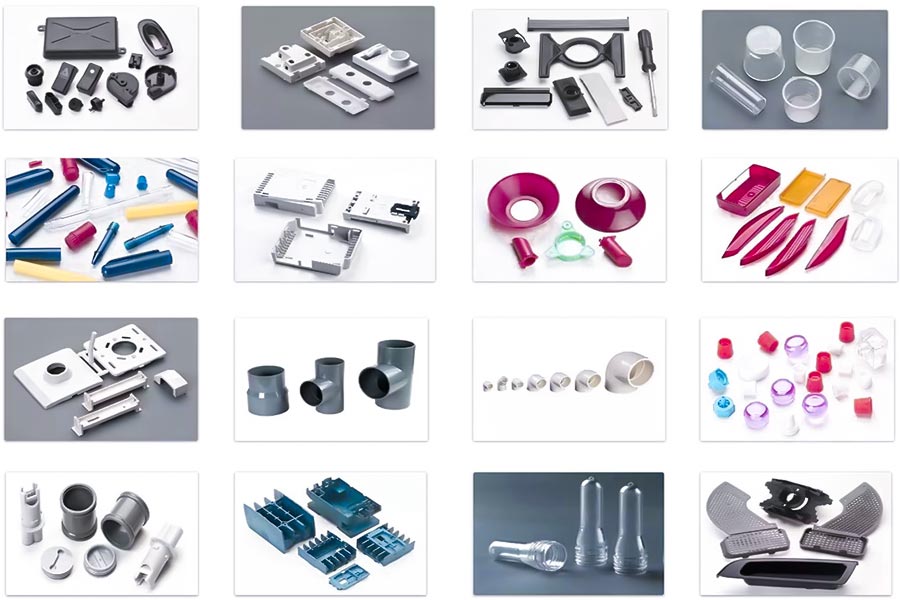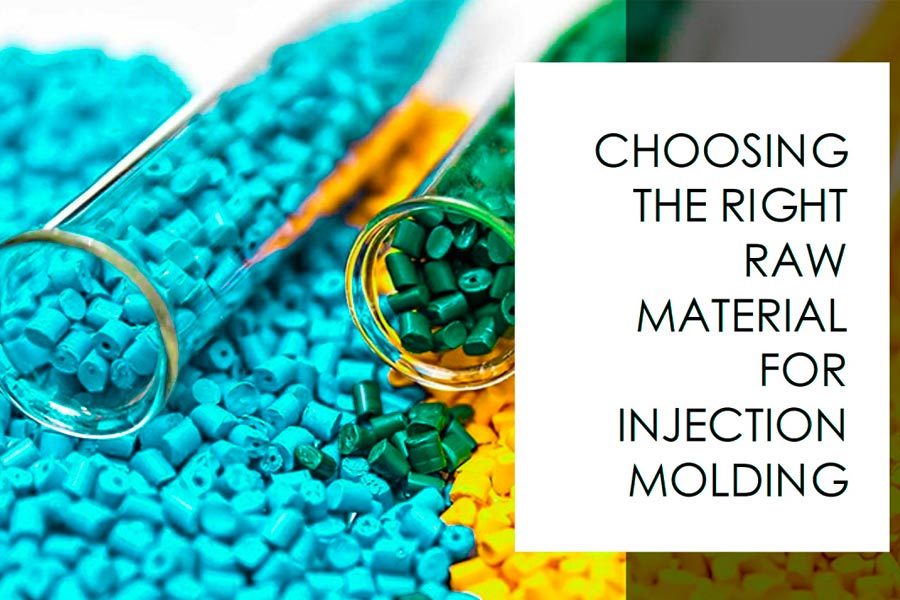Injection molding is a revolutionary plastic molding technology in modern manufacturing industry. The core principle is to inject molten plastic into precision mold cavity, cool and solidify, and obtain plastic products with specific shapes. The process combines the wisdom materials science, fluid mechanics and precision machinery to achieve plastic molding leap from traditional hand molding to highly automated mass production.
Unlike traditional processing methods, injection molding has the unique advantage of being able to complete complex structure molding in one go. The technology has become a pillar process of plastic production, with about athird of the world's plastic products produced by injection molding. Its importance is not only reflected in the efficiency and economy of production, but also in promoting infinite possibilities of product design. With the development of new materials and intelligent technology, injection molding is developing from simple molding process to advanced manufacturing system combining digitization and intelligence, constantly reshaping the face of modern manufacturing.

What is the core process of injection molding?
The core process of injection molding is essentially the spatial planning of thermoplastic materials during controlled phase transition. By molding injection, molten plastic is injected into the mold cavity with dynamics behavior, and the intelligent transition from viscous state to solid state is accomplished under the pre-set geometric constraints of the molding design.
Far from simply filling and cooling cycles, the process combines the synergy of material rheology, thermodynamic transfer and mechanical constraints: the mold is not only a container, but also a space conductor that guides the orientation of polymer molecules. The breakthrough of modern injection molding technology lies in adopting innovative means such as dynamic mold temperature control and multi-stage injection strategy to upgrade injection molding from basic manufacturing process to material properties redesign process. This is an essential characteristic that distinguishes it from other plastic moldings technique.
What are the characteristics of liquid silicone injection molding process?
1.Active flow at low temperature and pressure
Unlike thermoplastic injection molding, LSR maintains its liquid characteristics during injection and is cross-linked and solidified in the mold by platinum catalysis, allowing it to perfectly replicate the structure of the mold at a tiny scale.
2.Self-healing mold adaptation
The unique elastic memory effect of silicone material can automatically compensate the defect of low tolerance of die and reduce flash defects in silicone molding process, which is the dynamic bonding that rigid plastics cannot achieve.
3.Molecular programming for biocompatibility
By adjusting the A/B group ratio, the hardness of the material can be customized at injection to achieve the performance transition from medical catheter to seismic seal.
4.Reverse temperature control logic
Whereas traditional injection molding relies on mold cooling, LSR requires heating to initiate solidification (usually 170-200°C), completely reconstructing the molding equipment's thermal management system.
5.4D Forming Potential
Semi-curable silicone products has the characteristic of shape memory, allowing deformation recovery through secondary heating in the later stage, providing a new manufacturing paradigm for deformable structural components.

What industries is injection molding used for?
Injection-molding is reshaping the manufacturing boundaries of the following industries through material innovation and interdisciplinary technology integration, offering solutions that traditional processes cannot achieve:
| Industry | Innovative scenarios | JS core technology | Data indicators |
| Aerospace | Fuel nozzle, satellite mount. | Metal powder+carbon fiber reinforced injection molding. | Temperature resistance of 300°C, weight reduction of 60%. |
| Agricultural Machinery | Intelligent irrigation valve. | PA12+graphene enhanced+integrated sensor interface. | Resistant to salt spray for 10 years, with a threefold increase in lifespan. |
| Medical treatment | Respiratory masks, implants. | LSR silicone+UV online sterilization. | Daily production of 50,000 pieces, sterilization efficiency of 99.9%. |
| Robot automation | Biomimetic finger joints, encoder housing. | Dual color silicone TPU injection molding+modular design. | Grasping accuracy ±0.1mm, cost reduced by 40%. |
| Recyclable energy | Wind turbine bearing cover, energy storage housing. | Chemical recycling of marine plastics+PA11 biobased materials. | Recovery rate of 95%, carbon reduction of 70%. |
Unique Value
Injection-molding technology has broken through the role of traditional large-scale production tools and become the core driver of technological innovation across industries:
- Aerospace: Lightweight structures in extreme environments through 3D-printed moulds and composites.
- Healthcare: Combining LSR silicone with online sterilization technology to meet rapid delivery needs during the epidemic period.
- New energy: Closed-loop application of marine plastic recycling materials for sustainable development.
For example, a certain company has redefined the manufacturing standards for deep space exploration by using multi layer co injection-molding technology to achieve temperature cycling testing from minus 150°C to 200°C for the radiation resistant sensor housing of a Mars probe injection molding.

How to choose mold design materials in extreme environments?
In the field of injection molding in extreme environments, mold materials have shifted from passive defense to active adaptation. The following are innovative solutions to different extreme working conditions:
| Extreme environmental types | Material scheme | Core technology breakthrough | Application scenario cases |
| High temperature corrosive environment | Tantalum carbide nano coating mold. | Self generated antioxidant protective layer (does not fail at 1800℃). | Injection molding of high-temperature resistant resin components for aircraft engines. |
| Ultra low temperature environment | High entropy alloy composite mold. | Grain boundary engineering achieves toughness at -200℃. | Low temperature forming of seals for liquid hydrogen storage tanks. |
| Strong corrosive environment | Amorphous alloy molds. |
The absence of grain boundary structure prevents electrochemical corrosion.
|
Injection molding of fluoroplastic valves for chemical use. |
| Deep sea high-pressure environment | Gradient porous titanium alloy mold. | 3D printing controllable pore structure balances pressure transmission. | The pressure resistant shell of the submersible is integrated and formed. |
| Microgravity in space | Magnetic levitation intelligent mold system. | Superconducting magnetic field achieves contactless shaping. | Precision components for space stations are manufactured in orbit. |
Common characteristics of these innovative materials are:
- From homogeneity to heterogeneity: Performance breakthroughs through multi-scale structural design such as nanocoatings + macropores.
- Static to dynamic: Some new materials can adjust their microstructure automatically according to environmental parameters.
- Single-to-composite: Combines properties that traditional materials cannot coexist with, such as high strength and toughness.

How to inject the casing of household appliances?
1.Mold decoration (IMD+) technology
- Breakthrough point: Combining JS nanoscale transfer membranes to integrate 3D textures, metallic gloss, and fingerprint-resistant coatings during plastics molding to avoid secondary processing.
- Case in point: JS Injection molding premium brand refrigerator door panel with 0.1mm ultra-fine drawing texture with 99.8% yield rate.
2.Dynamic temperature control mold system
- Breakthrough point: Using JS's self-developed AI temperature control algorithm, the temperature of each area of the mold (accuracy ±1°C) is adjusted in real time, eliminating warping deformation of large shell.
- Case: 55-inch TV front frame injectable molding with a flatness error <0.05mm (industry standard 0.2mm).
3.Direct injection of eco-friendly composites
- Breakthrough point: Straw fiber reinforced plastic (up to 40%) can be injected directly through JS special screw design, with a strong wood feel and strength.
- Case in point: JS offers carbon neutral shell solutions for international brand air purifier.
4.Ultra-high speed thin-walled injection molding
- Breakthrough point: Utilizing JS ultra responsive injection system, the 1.5mm wall-thickness household appliance shells can be injected into the mold for 3 seconds, reducing energy consumption by 35%.
- Case in point: Robot vacuum cleaner shell mass production efficiency increased by 300%.
5.Intelligent health material injection molding
- Breakthrough point: Combining JS patents The antibacterial/antiviral masterbatch is evenly dispersed during plastics molding, effectively inhibiting surface microorganisms over the long term.
- Case in point: JS provided antibacterial panels for an ISO 22196 certification kitchen appliance brand.
What are the requirements for injection molding of surgical instruments?
The following is an innovative solution analysis of injection molding requirements for surgical instruments combined with the unique advantages of JS precision manufacturing:
Ultra-clean material adaptation system
1.Biocompatibility matrix screening
Based on various medical-grade polymers in the JS material library (e.g. PEEK, medical silicone, transparent polycarbonate), a material adaptation model for instrument use developed, and special alloys (e.g. molybdenum titanium alloys) that have passed ISO 10993 cytotoxicity testing are prioritized for long-term instrument implantation.
2.Pre treatment of infection-resistant surface modification
Combining plasma immersion ion implantation with nano silver, an antibacterial microstructures was established within the cavity of injection moldings to form a long-lasting (>500 cleaning cycles) antimicrobial layer on the instrument surface (Escherichia coli inactivation rate>99.9%).
Submicron level precision manufacturing matrix
1.Dynamic tolerance compensation system
Using JS patented closed-loop temperature controlled injection molding system (±0.002°C accuracy) combined with real-time pressure sensing (resolution 0.1MPa) in the die cavity, component size stability of 0.1 wall thickness was ±0.003mm, satisfying the assembly requirements of microsurgical instruments.
2.Multi material integrated molding process
The development of gradient injection molding technology allows seamless connection between hard metal (e.g. stainless steel) and flexible TPU soft tissues in a single molding process, with shear strength exceeding 25MPa, exceeding the fatigue life limit of traditional bonding processes (a more than 3 increase).
Medical grade cleaner production chain
1.100,000 level clean unit cluster
The injection molding workshop is equipped with an ISO 7 purification system, AGV material transfer and dust-free packaging workstations with dust concentration less than 0.5 μg/m³, which meets the requirements of the U.S. Food and Drug Administration's QSR sterile instrument production environment control.
2.Closed loop traceability management system
Each injection molding piece is equipped with an RFID chip that integrates data from more than 200 dimensions such as raw material volume, injection parameters (pressure/ temperature/ velocity), quality inspection results, and more to support electronic record traceability of FDA 21 CFR Part 11 standards.
Extreme working condition verification system
1.Accelerated aging test matrix
The reliability of the instrument in cases of extreme emergency surgery was ensured by triple verification of temperature cycling (-40°C to 130°C, 1000 cycles), chemical corrosion (72 hours soaking with 75% ethanol) and mechanical fatigue (100,000 opening and closing tests).
2.Bioburden extreme challenge
The most serious contamination conditions (MRSA biofilm loading 10^7 CFU/cm²) were simulated, using JS's self-developed enzymatic cleaning process, the residual protein content on the surface of the instrument is less than 2μg/cm², meeting the EU MDR Class III sterilization standard.
Intelligent composite specification output solution
1.One-stop authentication acceleration Kit
Provide two-track FDA 510(k) and CE MDR dual track certification consulting services, including a complete set of registration documents such as risk analysis reports (ISO 14971), biocompatibility data package, sterilization validation schemes, etc., reducing the average certification cycle by 40 days.
2.Digital twin delivery system
Simultaneously, 3D functional simulation models of the instrument, material microstructure analysis reports and manufacturing process parameter files (derived from MES system) are provided to assist clients quickly complete preclinical validation.

What is the environmental tolerance of military injection molded parts?
Breakthroughs in environmental tolerance technology
1.Ultra-wide temperature range stability
- The material passed an extreme temperature change test of -55°C to 180°C (-40°C to 125°C in conventional military standards) with a the thermal deformation rate less than 0.3% (0.5% on average for industry).
- Specially formulated fiberglass reinforced PA66 material have a strength retention rate of greater than 90% after wet-heat aging of 85°C/ 85% RH for 3000 hours.
2.Innovation in resistance to medium penetration
- Using nanoscale gas-phase silica, PCT assays (121°C/ saturated vapour) showed no silver lines for 240 hours.
- After 96 hours of soaking in fuel, the volume expansion rate is less than 0.2%, better than the MIL-DTL-53022G standard.
3.Dynamic load strengthening
- Under simulated artillery vibration conditions (10-500Hz/ 30Grms), the critical dimension change after 10^7 cycles is less than 0.02mm.
- The impact resistant ABS substrate passed the 100J drop hammer test (notch specimen), and the crack propagation rate was reduced by 60%.
Environmental Adaptation verification system
| Test dimension | Testing standards | JS measured indicators | Industry benchmark comparison |
| High and low temperature cycle | MIL-STD-810H Method 503 | -55℃ to 125℃/100 cycles without failure. | The standard requires -40℃ to 85℃. |
| Salt spray corrosion | ASTM B117 | 480 hours without red rust. |
The standard requires 240 hours.
|
| Ultraviolet aging | ISO 4892-3 | 1000 hours, color difference ΔE <1.5. | The standard requires 500 hours. |
| Low pressure simulation | GB/T 2423.21 | The sealing performance is intact at 10^-3Pa/24h. | Conventional 10^-1Pa test. |
JS converts precision machining accuracy (±0.005mm) into micrometer level protective structure control capability that combine with 23 military-specific grades in the materials genome database to form customized solutions across the land, sea, air, and space domains. The company's production base is equipped with a thermostatic ±0.1°C clean workshop and a dust-free 100,000 level dust-free laboratory, which provides comprehensive support for high-reliability components from design simulation to mass production.
How can JS company reduce costs for small batch injection molding?
JS reduced the cost of small-scale injection molding by 30%-50% through professional technology and process optimization. The specific plans are as follows:
Digital pre-production system
1.Virtual validation replaces physical trial modeling
- Forecasting shrinkage rate and warping deformation (error less than 0.01mm) by CAE simulation technology reduces mold trials frequency by 70%
- Die flow analysis software automatically matches the most optimal gate position, eliminating the loss traditional debugging consumables consumables.
2.Smart quotation system
- The 3D model automatically identifies features (such as stiffeners/buckles) and generates a BOM cost list in less than 3 seconds.
- Real-time integration of global chemical raw material price index, dynamic recommendation of the most cost-effective raw material combination.
Flexible Manufacturing System
| Pain points of traditional mode | JS Innovation Solution | Cost impact |
| Excessive investment in molds | Magnetic detachable insert mold. | Reduce the cost of single cavity molds by 60%. |
| Changing lines takes a long time | Robot automatic spraying release agent system. | The time for changing lines has been shortened to 8 minutes. |
| High marginal cost for small batches | Dynamic scheduling algorithm optimizes equipment load. | Cost reduction of 45% for minimum order quantity of 100 pieces. |
Material Innovation
1.Recycled material plan
- Customers can choose JS recycled aerospace grade ABS/PC alloys (performance degradation <3%).
- Cost savings of $800-1200 per tonne of recycled material.
2.On-demand synthetic technology
- Custom modified plastics such as flame retardant PA12 were synthesized on-site using molecular level 3D printing.
- Reduce intermediary premiums and reduce material costs by 25%-40%.
Whole life cycle cost control
- Embedded service life prediction chip: Injection molded parts is equipped with IoT sensors that can monitor fatigue life in real time and provide feedback to optimize subsequent batch processes.
- Carbon footprint deduction mechanism: Customers using biodegradable materials such as PHA can deduct their annual carbon emissions tax.
Typical case: A drone customer was supposed to buy 1000 custom antenna covers. Only three prototypes were used for validation and mass production through JS's digital twin pre production and mold technology. Total costs are down 67% compared to traditional model, with distribution times compressed to 12 days (an industry average of 30 days).
Summary
Injection molding has already surpassed traditional molding meaning, which is not only a simple process of injecting molten plastic into molds, but also a modern technology combining materials science, precision engineering and intelligent manufacturing. From nanoscale medical devices to meters long aircraft, molding plastic is reshaping the manufacturing boundaries of industries with incredible creativity. The real appeal of this technology lies its limitless possibilities.
Injection molding always brings amazing solutions when new materials encounter intelligent processes and innovative designs that break through traditional limitations. We are on the cusp of a manufacturing revolution where entrepreneurs, engineers and product designers have the opportunity to realize their innovative vision through this technology.
Disclaimer
The content on this page is for general reference only. JS Series makes no express or implied warranties regarding the accuracy, timeliness, or applicability of the information provided. Users should not assume that the product specifications, technical parameters, performance indicators, or quality commitments of third-party suppliers are completely consistent with the content displayed on this platform. The specific design feature, material standards, and process requirements of the product should be based on the actual order agreement. It is recommended that the purchaser proactively request a formal quotation and verify product details before the transaction. For further confirmation, please contact our customer service team for professional support.
JS Team
JS is an industry leading provider of customized manufacturing services, dedicated to providing customers with high-precision and high-efficiency one-stop manufacturing solutions. With over 20 years of industry experience, we have successfully provided professional CNC machining, sheet metal manufacturing, 3D printing, injection molding, metal stamping and other services to more than 5000 enterprises, covering multiple fields such as aerospace, medical, automotive, electronics, etc.
We have a modern factory certified with ISO 9001:2015, equipped with over 100 advanced five axis machining centers to ensure that every product meets the highest quality standards. Our service network covers over 150 countries worldwide, providing 24-hour rapid response for both small-scale trial production and large-scale production, ensuring efficient progress of your project.
Choosing JS Team means choosing manufacturing partners with excellent quality, precise delivery, and trustworthiness.
For more information, please visit the official website: jsrpm.com
FAQs
1.Is injection molding suitable for mass production?
Injection molding is very suitable for mass production. A set of molds can produce hundreds of thousands to millions of pieces, high efficiency, low cost, especially suitable for large-scale production of standardized products.
2.Are injection molded parts resistant to high temperatures?
The temperature resistance of injection molds depends on the material. Ordinary plastics can withstand temperatures between 60℃ and 100℃, while engineering plastics such as PEEK can withstand temperatures above 260 degrees Celsius. Special formula can further enhance heat resistance.
3.Can injection molded parts be recycled?
Thermoplastic injection molding parts can be recycled, but need to be classified, and thermosetting plastics are not recyclable due to chemical crosslinking. Recycled materials are often downgraded for use, leading to a degree of performance degradation.
4.How long is the lifespan of injection moldings?
Injection moldings typically last between 100,000 and 1 million weeks, depending on the material, type of plastic and level of maintenance. Precision molds can reach more than 5 million times.






